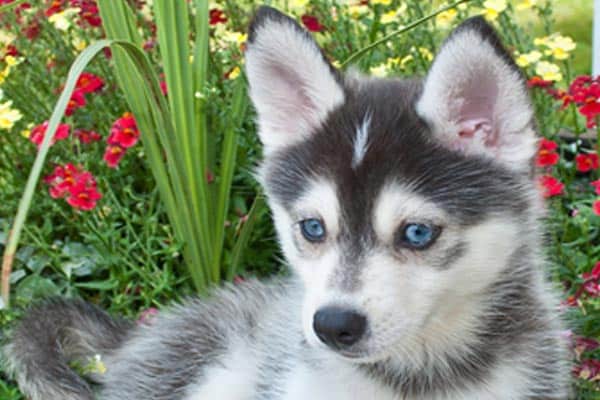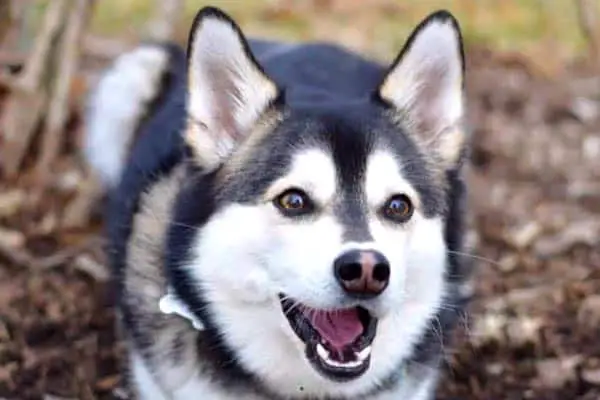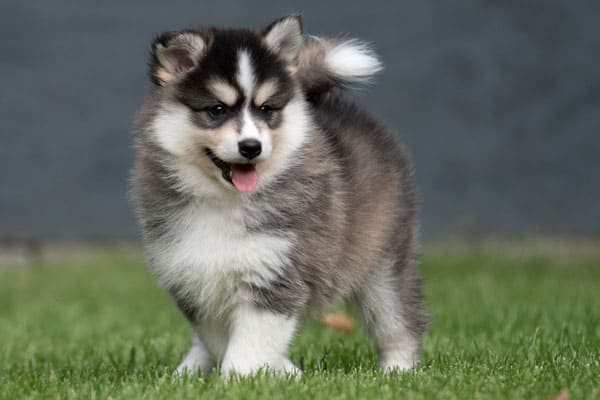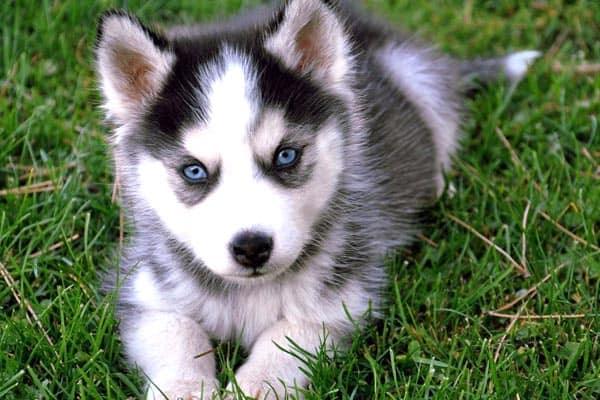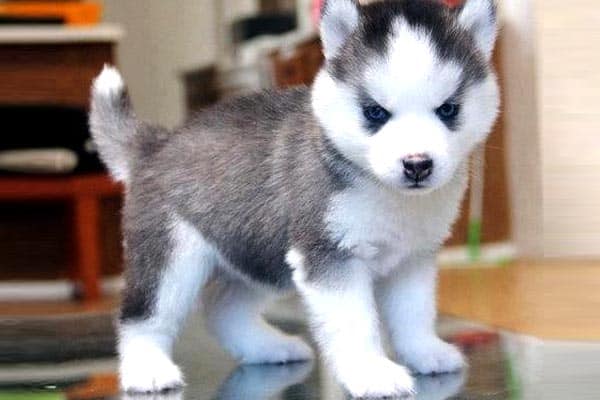Are Pomskies Good With Cats: What You Should Know Before Bringing a Pomsky Home
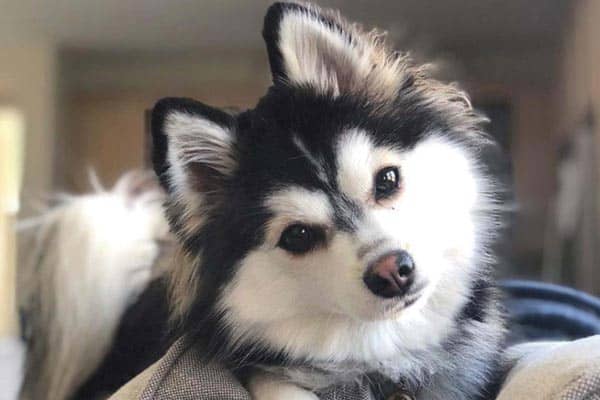
The Pomsky is the “it” hybrid or designer dog breed right now. Everyone has fallen in love with these fluffy miniature pups.
Pomskies have one Pomeranian dog parent and one Siberian Husky dog parent, which explains why so many fans call them “mini Huskies.”
But the Pomsky may not be the best choice if your family includes pet cats. Pomskies can get along well with cats but only under certain specific conditions, which we will delve into in this article.
Are Pomskies Good With Cats?
The simple answer to this question is “it depends on the individual dog and cat.” Pomskies can be good with cats if introduced properly right from the start. However, Pomskies can also inherit a strong prey drive and instinct to chase from the Siberian Husky parent dog. This can be a danger if you have a kitten or small cat. To be safe, never assume a Pomsky will get along with your pet cat. Supervise all interactions until you feel confident they have become friends.
Watch a Pomsky and a Cat Playing Together
This sweet YouTube video gives you a glimpse into the best-case scenario of bringing a Pomsky into your home when you already have a pet cat.
Adding a new pet when your family already includes animals is never something to do spontaneously. You don’t want to assume two animals will get along.
In the remainder of this article, we will talk about strategies to introduce your new Pomsky to your cat and pave the way for a new friendship.
What Do Pomsky Breeders Say About Pomskies and Cats?
The majority of Pomsky breeders say that Pomskies get along great with pet cats, kids, other dogs, and other family pets.
This is probably very accurate from the Pomsky breeder’s perspective. After all, they are Pomsky experts.
For example, Rose Peek Pomskies says that Pomskies are amazing with cats, other dogs, and kids. But the breeder also emphasizes that socialization in the first year of life is key to success.
Apex Pomskies also says that Pomskies are great with cats. Here again, notice that the breeder specifically states that their Pomskies are raised right alongside their family’s cats.
Breeders work with Pomsky dogs all day, every day. They know how to train Pomskies.
Pomsky breeders also understand how to work with the strong drives and instincts that can cause Pomskies to run and chase fast-moving objects, including other family pets.
So when your Pomsky breeder tells you that Pomskies get along great with cats, your next question should always be to ask how you can make sure that your new Pomsky will get along with your pet cat.
This is especially vital information if this will be your first time training a dog or your first time living in a family where you have both a cat and a dog.
What If Your Pomsky Doesn’t Like Your Cat Or Vice Versa?
As VetStreet points out, Pomskies are not generally regarded to be “cat-friendly” dogs.
But how could this be when Pomsky breeders say these dogs get along great with pet cats?
There are two main reasons why a Pomsky and a cat might not get along.
1. They just don’t like each other
The first reason a Pomsky and a cat might not get along is simply that not all cats and dogs get along.
It is tempting to think that non-human species don’t have strong feelings about who their friends are, but that all changes once you have witnessed two animals who should get along and simply don’t.
Sometimes a dog might just not like a cat or vice versa. This is always a possibility, even though it is not always easy to understand why it happens.
But if it happens, you can still train your cat and your dog to tolerate each other’s presence and minimize the risk of harm coming to either animal.
According to the ASPCA, this is one main reason why an existing pet might end up being relinquished to a shelter or rescue organization. Sometimes no matter what you try, two animals just don’t get along.
2. They haven’t been trained to get along
Sometimes the reason that a Pomsky and a cat don’t get along boils down to training – or lack thereof.
As we mentioned here earlier, when Pomsky breeders report that Pomskies get along well with cats, they are usually talking about Pomskies that they have whelped and trained in puppyhood and who have never known a life without cats.
When a Pomsky is raised with cats from birth, there is a much greater chance that the puppy will get along well with cats in general.
However, this still doesn’t speak to whether your existing cat will get along with your new Pomsky!
Even if your pet cat is used to having dogs around, this doesn’t automatically mean your cat will decide your Pomsky is a new friend. Your cat might view your Pomsky as a threat or as a competition.
Luckily, there are training techniques you can use to help your cat adjust to your new Pomsky, as we will discuss here next.
Is the Pomsky One of the Dog Breeds That Get Along Well With Cats?
According to American Humane, some dog breeds are more likely to get along with pet cats than other dog breeds.
Unfortunately, Pomsky is not one of them.
This is because the Pomsky will inherit some degree of the instinct to chase small fast-moving objects (called the “prey drive”) from both parent dogs, but particularly from the Siberian Husky parent dog.
Both the Siberian Husky and the Pomeranian are descended from the same basic genetic line of Arctic spitz dogs.
As the American Kennel Club (AKC) explains, Arctic Spitz dogs have been specifically bred to help with sled transportation, load-hauling, nose work, hunting, and even herding.
This can make spitz-type dogs nippy and aggressive, especially in puppyhood during teething and before they have been thoroughly trained.
While the Pomeranian dog breed is not technically considered a working dog breed due to its tiny size, these dogs do still have the thick double-layer coat of the spitz dog and still retain the prey drive of their larger canine genetic relatives.
Siberian Huskies are still used for mushing (sled racing) and hunting today and have a very strong instinct to run and chase and hunt.
Pomskies generally weigh between 20 and 30 pounds when they are fully grown, which means they will outweigh most family cats. Pomskies typically stand 10 to 15 inches tall, which means they will also be taller than most cats.
So a Pomsky that has both a height and weight advantage and has a strong chase or prey instinct will definitely pose a threat to a cat unless you take these deliberate steps to socialize the two animals together right from day one.
How to Train Your Pomsky and Your Cat to Get Along
The first step in training your Pomsky and your cat to accept each other, tolerate each other’s presence, and (hopefully) become friends is to follow these steps to the letter.
1. Pay close attention to animal body language
Best Friends Animal Society says that it is very important to pay close attention to the body language of both your dog and your cat when making introductions.
Even if you don’t know your new Pomsky well yet, you do know your pet cat well. So you can tell if your cat is responding positively or negatively to your Pomsky’s presence.
If you see signs that your cat is feeling defensive or scared, or threatened, you can separate the two animals right away and give your cat some time to calm down.
2. Choose a neutral location for the first meeting
This might be more difficult if your cat is an “inside cat” and does not like to travel. It can cause more harm than good if you have to pack a travel-hating indoor cat into a carrier to move to a neutral location for the initial meet-and-greet.
But if you can manage it safely and without undue stress for your cat, try to choose a more neutral area for the first meet, such as your backyard, driveway, or even a garage.
If you can’t take your cat out of the home for any reason, then at least pick a more neutral room for the first meet. Don’t bring your new Pomsky into your cat’s favorite room or near your cat’s toys or food bowls.
As PetMD recommends, another option to prepare your cat ahead of time is to bring something that smells like your Pomsky into your home in advance.
This can help your cat learn to associate the smell of your Pomsky with a non-threatening environment before you bring your dog home.
3. Keep the first introductions short and leashed
If your cat is willing to wear a harness, this is ideal. But even if your cat isn’t a fan of leashes or harnesses, you should definitely keep your new Pomsky leash to control the instinct many dogs have to chase cats.
This way, you can avoid causing your cat to freak out unnecessarily when your Pomsky spies what they think is a new fun playmate and goes charging over for a greeting.
4. Install protective measures in your home until training is complete
WebMD for Pets strongly recommends the use of baby or dog gates and other protective measures, such as crating for dogs until you are sure the two animals are safe around each other unrestrained.
Also, make sure your cat always has an outlet to get away from your Pomsky, whether that be a nearby cat tree or a baby gate, to stop your Pomsky from following into another room.
Also, be sure to feed your new Pomsky and your cat in separate rooms at separate times to avoid food jealousy or aggression.
5. Don’t be afraid to reach out for professional help
As the Pomskies Owners Association points out, Pomskies are known to have some traits that make them harder to train.
These same traits tend to be the traits that pet cats dislike. Pomskies have a high chase instinct (prey drive). They love to dig and chew and run and jump. They bark and whine a lot. And they want your total attention all the time.
This can make training a Pomsky challenging even for an experienced dog owner who isn’t having to manage interactions between a dog and an existing pet cat.
If this is your first time owning and training a dog or your first time introducing a dog to a pet cat, you may want to take the help of a professional animal trainer to learn the ropes.
Even just a few sessions can potentially transform a difficult situation into a much happier home life for all.
When to Reconsider Adding a Pomsky to a Family with Cats
Finally, there are some situations where it may not make smart sense to add an energetic, nippy, and rambunctious Pomsky puppy to a family that includes a cat.
The number one reason would be if your cat is elderly or has medical issues.
Pomskies love to play and chase and jump and run and your cat may be too old or health-compromised to cope with that without resorting to scratching or biting.
The number two reason is if your cat has had negative reactions to dogs in the past or is a rescue with a history of trauma or abuse.
Sometimes all the love in the world can’t entirely overcome the memory of past trauma. You know your cat best and can consider whether a dog might be too stressed.
These tips can help you can pave the way for friendship between your Pomsky and your cat.
